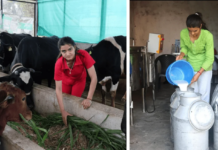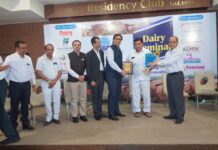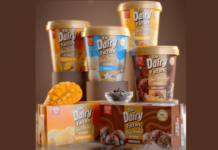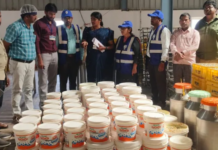New Delhi, January 25, 2020:
Abstract
Camel milk: The white gold of desert has splendid therapeutic and nutritional benefits which are not well aware among the people. Camel milk is an alternate source of dairy product to lactose intolerant, diabetes, autism affected people. The drastic decline in the population of camel is making anxious as per Indian scenario, but different state governments are coming forward to promote camel rearing and its milk and byproduct consumption in India which may enhance the population rate as well as the milk consumption rate.
Introduction
Milk has been a part of human nutrition since time immemorial. Ancient people started rearing animals once they changed to small community from nomadic tribal society for reducing their work loads. Later people started to use the byproducts of these domesticated animals such as milk. Because of rich in nutrients it has been consumed in different forms. India stands first in the consumption of milk with major production. Dairy industries in India is enormously successful with buffalo and cow milk rather than camel milk. The nutritional importance of camel milk is not well known because of its constrained distribution in Rajasthan and Gujrat. But now the Governments of both states promote and invest in camel dairying. In this decade our country is not only consuming camel milk but also various byproducts like ice-creams and milk powder (Bhakat and Sahani 2006).
Camel Dairying in India
Indian camels have the unique adaptive characteristics to survive in hot arid zones. In India the major reared breeds of camels are Bikaneri, Jaisalmeri, Kachchi and Mewari. The distribution of camels in India are mainly constrained in Rajasthan and Gujarat since their physiology is suitable for the dry desert climate. Reports show that in 2012 the camel population was 4 million. But later a drastic decrease in the number of camels were observed and according to 2014-2015 camel population no more than 3 lakhs camels were found (Meena, A et al 2018) The current scenario shows the state animal of Rajasthan; Camel may figure out by IUCN Red list in near future as a critically endangered species. In this context awareness of camel rearing is necessary. The camels are reared based on traditional knowledge for self-domestic use, breeding and selling purpose and people are not known about nutritional value of camel milk.
Human –Camel Relationship
Historically Raika/ Reberi community of Rajasthan is closely associated with the camel in India and these communities observed several taboos for their utilization. They are not allowed to slaughter or eat the meat, can’t sell the meat nor the wool, nor the female camels. The only benefit of rearing camels to this particular community is that their traditional customs allowed them to sell male camels. However now this kind of beliefs are given way to pragmatic attitude and most of the camel breeders are aspire to sell camel milk for surviving economically by sticking to hereditary profession (Faye B 2004).
In reaction to the drastic decline in the population of camel, Rajasthan Government declared Camel as their State animal in 2014 and camel breeders released a “Biocultural Community Protocol” in 2017 for its protection. Now the Government is actively supporting camel rearing because of its less population and the nutritional, therapeutic importance of its milk.
Nutritional composition of Camel Milk
Camel milk is generally opaque white with sweet and sharp taste. But the taste and quality of the milk which camel produce is depend upon the types of plants which the camel feed on. Reports shows that the plants like bordi and untkantalo makes the milk sweet and neem makes it more bitter and salty. The pH and density of camel milk ranges from 6.5-and 1.025-1.032 g/cc respectively and which is lower than the cow’s milk. When the camels are restricted to have water, the water present in the milk will be high of about 91%, whereas, the water content in the milk will reduce to 86% when water freely available. The first colostrum of camel is white and diluted as compared to cow’s colostrum with total solids of 30.4%, protein (19.4%), lactose (7.2%), minerals (3.8%) and fat (2%). After few days the total solid content fell to 18.4% with protein content of 3% and minerals (0.1%). The fat content varies in the range of 2.7-3.6%. The major carbohydrate, lactose content in the camel milk is observed as 3.4-5.6% which is slightly higher than cow milk. Among 19 present amino acids, Proline, Glutamic acid, Serine, Threonine are found to be more than cow’s milk (Zibaee, S 2015), (Farah,Z 1993). Camel milk can suggest for milk allergic children or lactose intolerant people. In fact, camel is not a ruminant even though it ruminates. It is a tylopode. The milk composition is vastly different from other ruminants and the lactose present in the camel milk can easily metabolized by lactose intolerant people. The proteins present in camel milk can prevent and cure milk allergies because of the absence of β-lactoglobulin and β-caesin which are responsible for allergies. It is also rich in Vitamin C, Iron and Calcium with immunoglobulins compatible with human milk (Shabo,Y et al 2005).
Nomads consume camel milk as fresh because of the presence of natural antimicrobial proteins and medicinal properties of the milk. Some studies show that the extracted lysozyme, lactoferrin, lacto peroxidase, immunoglobulin G and immunoglobulin A from the camel milk works against Lactococcus lactis subsp. cremoris, Escherichia coli, Staphylococcus aureus, Salmonella typhimurium and rotavirus. Several articles were reported on the therapeutic importance of camel milk and it can be used for Rota viral diarrhea, diabetes, cancer, rickets, autism, tuberculosis, hepatitis, liver cirrhosis and to lactose intolerance or milk allergies and can improve general well-being.
Threats to camels (Bhakat et al 2006)
The threats which objects the camel survival are listed below
- Disappearance of the grazing land:
Over exploitation of nature causes the disappearance of grazing land and which is ultimately affect the population of camel. This results the camels having very less plants to eat and left by starving which makes them vulnerable to several diseases and this slows down its reproductive capacity.
- Spreading of contagious diseases.
Many camels lost their lives by the disease like Mange, a skin disease caused by parasitic mites and trypanosomiasis cause by protozoan parasites. Veterinary services are available only at veterinary hospitals or in medical camps and herders are finding difficult to bring sick camels to the hospitals all the time.
- Closure of traditional markets and reducing the male camel sale
When new rule came into existence in Rajasthan, it is very difficult to sell young camels. Even if this rule is for camel life protection this reduce the income of herders. So nobody is willing to buy herds and the new generation is moving to some other jobs without sticking into their traditional job.
- Camel milk Processing and Marketing
Lack of awareness of the therapeutic and nutritional benefits of camel milk and its constrained distribution are the reasons of its less availability in the market. Currently in India there is only one dairy “Kumbhalgarh dairy” officially accepts camel milk and pays a decent price to herders. Recently Amul started marketing of processed camel milk.
History of Camel Milk Processing and marketing of its products in India
Even though camel milk contains low fat and has high percentage of unsaturated fatty acids, the high vitamin and mineral content makes camel milk in the category of super foods. The history of camel milk consumption starts from long years back in Arabian countries. Since the camel population is less in India, it took time to market camel milk here (Mal and Pathak 2010).
In 1996 Dr Kohler-Rollefson (Nari Shakti 2016 awardee) set up a nonprofit firm “Lokhit Pashu Palak Sansthan (LPPS)” for the working of camel breeders in Rajasthan. In 2008 LPPS set up a dairy project near Jaisalmer and started supplying camel milk locally for diabetic patients and later they started a small micro dairy “Camel Charisma” with a production capacity of 150 liters in a week in 2011. This micro dairy has the capacity of pasteurizing and chilling of 200-liter milk in a single cycle. Apart from camel milk they are the producers of camel milk soap, camel poo paper etc.
People living in deserts have been taking advantages of camel milk since ages. So to improve the market of camel milk across the world, Aadvik foods started its journey with camel milk and its products from 2015. They are the manufactures of camel milk powder, camel milk chocolate apart from pasteurized milk.
FSSAI fixed the standards of camel milk to be sold commercially in 2016. FSSAI has framed the standards of camel milk specifying the minimum content of milk fat and milk solids-not-fats as 3% and 6.5% respectively, but after stakeholder’s consultation FSSAI bring down the value of fat (2%) and SNF (6%). Government aided dairy cooperatives in Rajasthan were worked hard for the standards even before FSSAI standards become public. Rajasthan’s decision to make camel as its State animal in 2014 led to restrictions in slaughtering which makes positive promotion in the use of camel milk and its products
Recently Amul also started marketing Amul Camel milk in 500ml PET bottles with for Rs 50. They claimed the shelf life of product is about 72 hours from the date of packing if kept under refrigerated condition or below 4℃.
Conclusion
In fact, the camel milk has been consumed by nomadic Arab people and other desert communities in various corners of the world to face their difficult condition from long years ago. Despite its availability, India is the late entrant in the marketing of camel milk and now the Governments of Rajasthan and Gujarat take initiative steps to promote camel milk and its rearing. Beyond a beverage it is a source of income to local herders and it is beneficial to the people who are suffering from different diseases like diabetes, autism, lactose intolerance. The challenges in the processing and marketing of camel milk is immense, but to embark in camel milk consumption and its marketing first of all awareness about its therapeutic importance should be done among public. Now India is witnessing the rising demand of camel milk which may fruitfully help in the protection of this critically endangered species of the desert.
References
- Meena, A. (2018). Camel breeds of India: Contemporary Overview. Journal of Veterinary Medicine and Surgery, (2) :42-43
- Bhakat, C., Chaturvedi, D., & Sahani, M. S. (2006). Camel production and management systems in different agro-ecological zones of Rajasthan. Annals of Arid Zone, 45(2), 195.
- Bhakat, C., & Sahani, M. S. (2006). Camel: A unique species in hot arid desert ecosystem. Everyman’s Science XL, 426-429.
- Farah, Z. (1993). Composition and characteristics of camel milk. Journal of Dairy Research, 60(4), 603-626.
- Faye, B. (2004). Dairy productivity potential of camels. of the Series: ICAR Technical Series.
- Mal, G., & Pathak, K. M. L. (2010). Camel milk and milk products. SMVS’Dairy Year Book, 97-103.
- Shabo, Y., Barzel, R., Margoulis, M., & Yagil, R. (2005). Camel milk for food allergies in children. IMAJ-RAMAT GAN-, 7(12),
- Zibaee, S. (2015). Nutritional and therapeutic characteristics of camel milk in children: a systematic review. Electronic physician, 7(7),
- https://amul.com.
- FSSAI Report
Corporate Comm India (CCI Newswire)

































